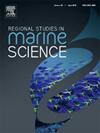Assessing the impacts of artificial inlet opening and freshwater extraction and on salinity and temperature gradients in a tropical coastal lagoon
IF 2.4
4区 环境科学与生态学
Q3 ECOLOGY
引用次数: 0
Abstract
The coastal lagoon of La Mancha, in Veracruz, Mexico, is a site of great biological, ecological, and economic importance because of its high biodiversity, tourism and fishing activities. Two current anthropogenic actions that could be altering this system are the artificial opening of the inlet by fishermen, to increase the inflow of marine organisms, and the extraction of fresh water to supply recent housing developments. To assess the impacts of these actions, a two-dimensional numerical model (Delft3D) was calibrated and validated, and the horizontal salinity and temperature gradients were simulated by varying the amounts of freshwater extraction for opened and closed inlet conditions in rainy and dry seasons. The results show that in open inlet conditions, even when the water discharged from the streams is varied due to the season, a very marked salinity gradient forms from north to south, with oligohaline, polyhaline, and euhaline conditions. When the inlet is open, in the northern part of the lagoon, most of the water body has high salinity values (35 ppt), and when the aperture closed, salinity dilutes throughout the system to mesohaline and polyhaline conditions (5−30). The freshwater demand associated with current developments in the surroundings of La Mancha, did not significantly modify the temporal and spatial distribution of temperature and salinity in the lagoon. However, the increasingly constant artificial opening of the inlet has implications for these gradients. The changes in salinity and temperature gradients are of great importance for the flora and fauna of these ecosystems. The inadequate and frequent opening of the water body to the sea alters salinity and temperature conditions which will greatly affect the biota, many of which are of commercial interest.
评估热带沿海泻湖人工入口开放和淡水提取对盐度和温度梯度的影响
墨西哥韦拉克鲁斯州的拉曼查海岸泻湖,由于其高度的生物多样性、旅游和渔业活动,是一个具有重要生物、生态和经济意义的地方。目前可能改变这一系统的两种人为行为是渔民人为打开入口,以增加海洋生物的流入,以及抽取淡水以供应最近的住房发展。为了评估这些行为的影响,对二维数值模型(Delft3D)进行了校准和验证,并通过在雨季和旱季打开和关闭入口条件下改变淡水提取量来模拟水平盐度和温度梯度。结果表明,在开放进口条件下,即使随季节变化,从北到南也形成了非常明显的盐度梯度,呈现出低盐、多盐和真盐的状态。当入口打开时,在泻湖北部,大部分水体具有高盐度值(35 ppt),当孔径关闭时,盐度在整个系统中被稀释到中盐和多盐状态(5 - 30)。与拉曼查周边地区当前发展相关的淡水需求并没有显著改变泻湖温度和盐度的时空分布。然而,不断增加的入口人工开放对这些梯度有影响。盐度和温度梯度的变化对这些生态系统的动植物具有重要意义。不充分和频繁地向海洋开放水体改变了盐度和温度条件,这将极大地影响生物群,其中许多生物具有商业价值。
本文章由计算机程序翻译,如有差异,请以英文原文为准。
求助全文
约1分钟内获得全文
求助全文
来源期刊

Regional Studies in Marine Science
Agricultural and Biological Sciences-Ecology, Evolution, Behavior and Systematics
CiteScore
3.90
自引率
4.80%
发文量
336
审稿时长
69 days
期刊介绍:
REGIONAL STUDIES IN MARINE SCIENCE will publish scientifically sound papers on regional aspects of maritime and marine resources in estuaries, coastal zones, continental shelf, the seas and oceans.
 求助内容:
求助内容: 应助结果提醒方式:
应助结果提醒方式:


